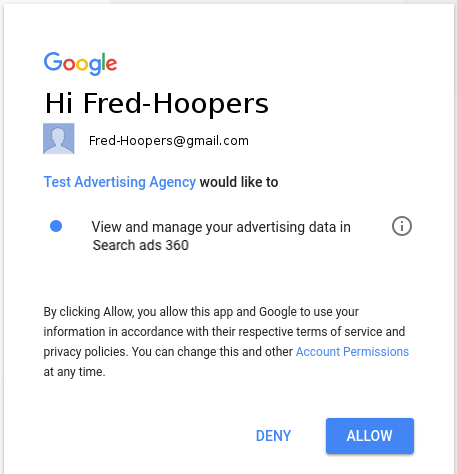Search Ads 360 API 要求所有请求必须指定 OAuth 2.0 访问令牌以进行身份验证。您可以按照任何标准 OAuth 2.0 身份验证工作流生成令牌,并将其传递给 Search Ads 360 API。我们建议您采用下述工作流程,因为它适用于完全自动化的转化数据上传和报告下载。
如需了解下述工作流的替代方案,请参阅为已安装的应用使用 OAuth 2.0 或
为服务器到服务器应用使用 OAuth 2.0。如果您使用其他工作流,请在请求 OAuth 2.0 授权代码时将以下值指定为 scope 参数:
https://www.googleapis.com/auth/doubleclicksearch
如果您采用服务器到服务器方式,请将服务账号添加为 Search Ads 360 用户。
推荐的授权工作流程
- 前往 Google API 控制台,然后选择您的项目。
如果您尚未创建 Google API 控制台项目和 OAuth 凭据,请按照为您的客户端创建 Google API 控制台项目和 OAuth 凭据中的说明操作。
如需查找项目的 OAuth 客户端 ID 和密钥,请执行以下操作:
- 打开“凭据”页面。
- 在名称列中,点击您的 OAuth 客户端的名称。
- 该页面上会列出客户端 ID 和密钥。
- 打开网络浏览器,然后使用有权访问 Search Ads 360 中的数据的 Google 账号登录 Google
。
这是您的 API 客户端将用来向 Search Ads 360 进行身份验证的 Google 账号。 如果 Google 账号持有人离开贵公司,并且您从该账号中移除了 Search Ads 360 访问权限,则需要重复此授权工作流程,并指定其他 Google 账号。
- 通过调用 Search Ads 360 实用工具脚本获取刷新令牌,具体操作步骤如下:
sa360Api.py --login该脚本会引导您完成使用 OAuth 客户端 ID 和密钥获取刷新令牌的过程。刷新令牌仅适用于您在上一步中登录的 Google 账号。
在此过程中,脚本会生成一个网址,并指示您在网络浏览器中访问该网址。
-
当浏览器要求您允许 OAuth 客户端访问 Search Ads 360 数据时,请确保系统显示您之前登录的 Google 账号。(如果您登录了多个 Google 账号,系统可能会显示其他账号。)

该过程结束后,
sa360Api.py脚本会输出一个以英文逗号分隔的字符串。第一个值是您提供的客户端 ID,第二个值是您提供的客户端密钥,第三个值是刷新令牌。在以下示例输出中,刷新令牌以粗体文本显示:
123456789123.apps.googleusercontent.com,ABCDEFGHIJKLMNOPQR_abcdef,1/HIJklM01OPQR23NOP456rst890uvw - 将客户端 ID、客户端密钥和刷新令牌存储在您的应用可访问的后端数据库或其他安全位置。
如果您打算使用
sa360Api.py将示例 JSON 请求发送到 Search Ads 360 API,请将整个以英文逗号分隔的字符串保存在方便访问的位置。您将在每次调用脚本时将整个字符串作为参数传递。 - 将用于执行以下操作的代码添加到应用中:
- 使用客户端 ID、客户端密钥和刷新令牌获取新的 OAuth 2.0 访问令牌。
- 使用新的访问令牌向 Search Ads 360 API 发送请求。
如果您使用的是客户端库,请参阅下一部分(设置应用),了解如何将此授权代码添加到您的应用。
如果您使用的不是上述任一客户端库,请参阅针对已安装的应用使用 OAuth 2.0,了解有关获取新访问令牌的建议。

